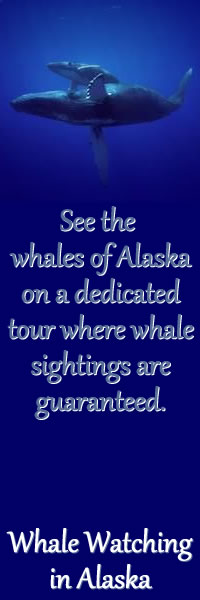Whale Watching in Alaska: When and Where Can You See Them?
Where to go Whale Watching in Alaska — Find the best times and places
to see whales in Alaska. Read through these get tips on booking whale watching tours in Alaska
for Humpback Whales, Orcas, Gray Whales and more.
- Beluga Whale — In Alaska there are different stocks of beluga whales found in the
waters around the states coastline:
- Cook Inlet — The Cook Inlet Beluga whales can been seen
early spring through fall from Kachemak Bay in Homer all along the inlet waters north to Anchorage. Current
count is estimated at 325 whales. The Cook Inlet Belugas are the most isolated and are
considered endangered due to their decreasing numbers. A popular spot to watch them
is the Beluga Point pull out along the Seward Highway just a short distance south of the
city of Anchorage.
- Bristol Bay — The estimated 40,000 Arctic Belugas spend their winter months in the
bays and shallow waters in the south western part of Alaska known as Bristol Bay. When
these waters warm up in the spring some of the whales begin to migrate north to the
Arctic Circle in Beaufort Sea.
- Eastern Bering Sea — Some pods of belugas stay in this region during the summer
months as others continue their migration northward the the Chukchi and Beaufort Sea.
- The best time to see the Beluga whales is during the summer months as they are
known to feed in the calm, shallow waters along the shore line and in bays.
- Orcas/Killer Whale — This largest member of the dolphin family, can
be seen throughout the North Pacific, along the entire west coast of North America from Washington
state's inside passage, British Columbia and along the entire Alaskan coast. They prefer the
cold, temperate waters in Alaska during the summer months. They can be found in the waters of
Southeast Alaska through the Aleutian Islands as well as north into the Chukchi and Beaufort
Seas following the retreating ice packs.
- Top locations to see these popular whales include Prince William Sound west through
the Kenai Fjords, the Gulf of Alaska and the Bering Sea. The largest abundance are found
in Southeast Alaska near Juneau and Ketchikan.
- The best time of year for whale watching success is during the months of May through
August.
- Humpback Whale — Another whale watching favorite are the 35 tons Humpback whale which
migrates north from their winter home near Hawaii and Mexico north along the Pacific west coast
to the cool waters of Alaska to feed during the summer months.
- Whale watching enthusiasts flock to the Cook Inlet, Prince William Sound, Southeast
Alaska and Kodiak where you are almost guaranteed to see these acrobatic sea creatures breaching,
tail-slapping, spy-hopping, charging and flipper slapping in family groups, sometimes for
hours at a time.
- Songs sung by the humpback can last for an average of 15 minutes and can be repeated
for hours. These songs are beautiful and often long, are only sung by the males.
- Gray Whale — Estimated to have been on earth for 30 million years,
the Gray Whale travels north in the early spring from the waters of Baja California following
the coast of California, Oregon, Washington and Canada on their way to Alaska's Bering, Chukchi
and Beaufort Seas. They leave in February and arrive in western Alaska's Bering
Sea in May and June.
- They can be seen feeding during the summer months along the coast of Bristol Bay,
St. Lawrence Island and Nunivak Island in Southwest Alaska. From April to
October you will liking spot these giant whales jumping partially out of the water only to
re-enter the water on their sides or backs with a big splash called breaching. They
can also be seen spy hopping which is when the whales pop only their heads up out of the water
and then slip back under the surface.
- Minke Whale — The Minke whales are fast swimmers and are curious, having
been known to approach ships and boats. However, they seem to prefer to stay under the
surface and may be spotted in groups of 2-3.
- In the spring they migrate north along the coastlines of Alaska and are common
in the Gulf of Alaska, Southeast Alaska and up to the Bering Sea. They can be hard to
spot as they don't breach like some of the other Alaskan whales. They usually
rise to the surface for air and are only visible for a short time making them a bit tricky
to spot among the waves.
- Dall's Porpoise — These spunky, active black and white porpoises are a joy
to watch. You can spot them in groups of 6 to 12 as they swim alongside ships and tour
boats creating sprays of rooster tails as they go. They can travel in speeds up to 55
miles per hour.
- Your best opportunity to see these spirited creatures is in the spring and summer
months. They can be found throughout the waters of Alaska; Resurrection Bay in Kenai
Fjords National Park, the Gulf of Alaska and Inside Passage to name a few. They are
best seen from the decks of a cruise ship or boat tour boats.
If you own or operate a tour business that includes Alaska Whale Watching in it's itinerary,
contact us today for a free review of your business. We will than include your listing on this
site allowing you to attract new clients and help your business prosper in the upcoming Alaska
whale watching season. |





